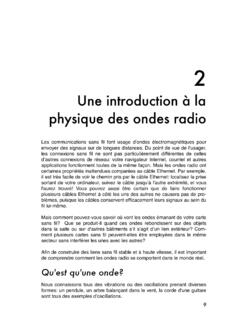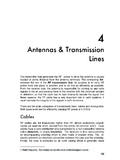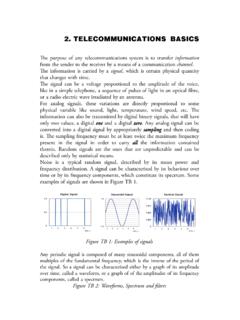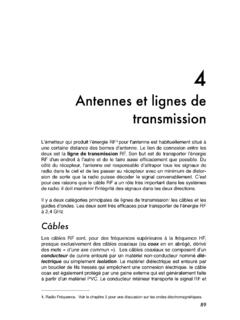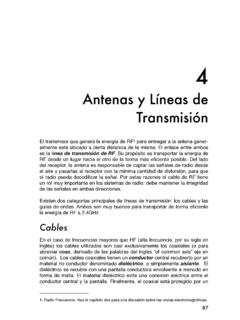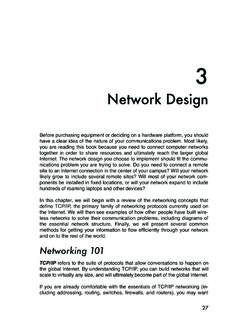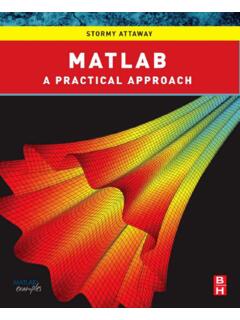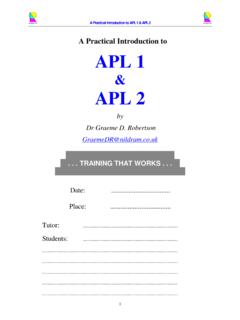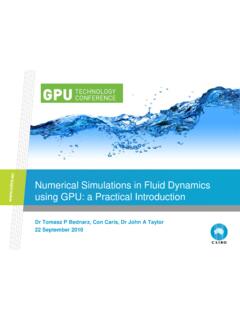Transcription of A Practical Introduction to Radio Physics - WNDW
1 2A Practical Introduction to Radio PhysicsWireless communications make use of electromagnetic waves to send sig-nals across long distances. From a user s perspective, wireless connections are not particularly different from any other network connection: your web browser, email, and other applications all work as you would expect. But Radio waves have some unexpected properties compared to Ethernet cable. For example, it s very easy to see the path that an Ethernet cable takes: lo-cate the plug sticking out of your computer, follow the cable to the other end, and you ve found it! You can also be confident that running many Ethernet cables alongside each other won t cause problems, since the cables effec-tively keep their signals contained within the wire how do you know where the waves emanating from your wireless card are going? What happens when these waves bounce off of objects in the room or other buildings in an outdoor link?
2 How can several wireless cards be used in the same area without interfering with each other?In order to build stable high-speed wireless links, it is important to understand how Radio waves behave in the real is a wave?We are all familiar with vibrations or oscillations in various forms: a pendu-lum, a tree swaying in the wind, the string of a guitar - these are all examples of they have in common is that something, some medium or object, is swinging in a periodic manner, with a certain number of cycles per unit of time. This kind of wave is sometimes called a mechanical wave, since it is defined by the motion of an object or its propagating such oscillations travel (that is, when the swinging does not stay bound to one place) then we speak of waves propagating in space. For ex-ample, a singer singing creates periodic oscillations in his or her vocal cords.
3 These oscillations periodically compress and decompress the air, and this periodic change of air pressure then leaves the singers mouth and travels, at the speed of sound. A stone plunging into a lake causes a disturbance, which then travels across the lake as a wave has a certain speed,frequency, and wavelength. These are con-nected by a simple relation:Speed = Frequency * WavelengthThe wavelength (sometimes referred to as lambda, ) is the distance meas-ured from a point on one wave to the equivalent part of the next, for example from the top of one peak to the next. The frequency is the number of whole waves that pass a fixed point in a period of time. Speed is measured in meters/second, frequency is measured in cycles per second (or Hertz, ab-breviatedHz), and wavelength is measured in example, if a wave on water travels at one meter per second, and it oscil-lates five times per second, then each wave will be twenty centimeters long:1 meter/second = 5 cycles/second * WW = 1 / 5 metersW = meters = 20 cmWaves also have a property called amplitude.
4 This is the distance from the center of the wave to the extreme of one of its peaks, and can be thought of as the height of a water wave. The relationship between frequency, wave-length, and amplitude are shown in Figure in water are easy to visualize. Simply drop a stone into the lake and you can see the waves as they move across the water over time. In the case of electromagnetic waves, the part that might be hardest to understand is: What is it that is oscillating? In order to understand that, you need to understand electromagnetic forces. 10 Chapter 2: A Practical Introduction to Radio Physicsamplitudeamplitudewavelength ( )wavelength ( )time: 1 secondFigure : Wavelength, amplitude, and frequency. For this wave, the frequency is 2 cycles per second, or 2 forcesElectromagnetic forces are the forces between electrical charges and cur-rents. Our most direct access to those is when our hand touches a door handle after walking on synthetic carpet, or brushing up against an electrical fence.
5 A more powerful example of electromagnetic forces is the lightning we see during thunderstorms. The electrical force is the force between electri-cal charges. The magnetic force is the force between electrical are particles that carry a negative electrical charge. There are other particles too, but electrons are responsible for most of what we need to know about how Radio us look at what is happening in a piece of straight wire, in which we push the electrons from one and to the other and back, periodically. At one mo-ment, the top of the wire is negatively charged - all the negative electrons are gathered there. This creates an electric field from plus to minus along the wire. The next moment, the electrons have all been driven to the other side, and the electric field points the other way. As this happens again and again, the electric field vectors (arrows from plus to minus) are leaving the wire, so to speak, and are radiated out into the space around the we have just described is known as a dipole (because of the two poles, plus and minus), or more commonly adipole antenna.
6 This is the simplest form of omnidirectional antenna. The motion of the electric field is commonly referred to as an electromagnetic us come back to the relation:Speed = Frequency * Wavelength Chapter 2: A Practical Introduction to Radio Physics 11In the case of electromagnetic waves, the speed is c, the speed of = 300,000 km/s = 300,000,000 m/s = 3*108 m/sc = f * Electromagnetic waves differ from mechanical waves in that they require no medium in which to propagate. Electromagnetic waves will even propagate through the vacuum of of tenIn Physics , math, and engineering, we often express numbers by powers of ten. We will meet these terms again, in Giga-Hertz (GHz), Centi-meters (cm), Micro-seconds ( s), and so of TenNano-10-91/1000000000nMicro-10-61/100 0000 Milli-10-31/1000mCenti-10-21/100cKilo-10 31 000kMega-1061 000 000 MGiga-1091 000 000 000 GKnowing the speed of light, we can calculate the wavelength for a given fre-quency.
7 Let us take the example of the frequency of wireless net-working, which isf = GHz = 2,400,000,000 cycles / secondwavelength lambda ( ) = c / f = 3*108 / *109 = *10-1 m = cmFrequency and wavelength determine most of an electromagnetic wave s be-havior, from antennas that we build to objects that are in the way of the networks we intend to run. They are responsible for many of the differences between dif-12 Chapter 2: A Practical Introduction to Radio Physicsferent standards we might be choosing. Therefore, an understanding of the basic ideas of frequency and wavelength helps a lot in Practical wireless important quality of electromagnetic waves is polarization. Polari-zation describes the direction of the electrical field you imagine a vertically aligned dipole antenna (the straight piece of wire), electrons only move up and down, not sideways (because there is no room to move) and thus electrical fields only ever point up or down, vertically.
8 The field leaving the wire and traveling as a wave has a strict linear (and in this case, vertical) polarization. If we put the antenna flat on the ground, we would find horizontal linear of propagationmagnetic fieldelectric fieldFigure : Electric field and complementary magnetic field components of an elec-tromagnetic wave. Polarization describes the orientation of the electric polarization is just one special case, and is never quite so perfect: in gen-eral, we will always have some component of the field pointing other directions too. The most general case is elliptic polarization, with the extremes of linear (only one direction) and circular polarizations (both directions at equal strength).As one can imagine, polarization becomes important when aligning anten-nas. If you ignore polarization, you might have very little signal even though you have the strongest antennas.
9 We call this polarization electromagnetic spectrumElectromagnetic waves span a wide range of frequencies (and, accordingly, wavelengths). This range of frequencies and wavelengths is called the elec-tromagnetic spectrum. The part of the spectrum most familiar to humans is probably light, the visible portion of the electromagnetic spectrum. Light lies roughly between the frequencies of *1014 Hz and *1014 Hz, correspond-ing to wavelengths from circa 400 nm (violet/blue) to 800 nm (red). Chapter 2: A Practical Introduction to Radio Physics 13We are also regularly exposed to other regions of the electromagnetic spec-trum, including Alternating Current (AC) or grid electricity at 50/60 Hz, Ul-traviolet (on the higher frequencies side of visible light), Infrared (on the lower frequencies side of visible light), X-Rays / Roentgen radiation, and many oth-ers.
10 Radio is the term used for the portion of the electromagnetic spectrum in which waves can be generated by applying alternating current to an an-tenna. This is true for the range from 3 Hz to 300 GHz, but in the more nar-row sense of the term, the upper frequency limit would be 1 talking about Radio , many people think of FM Radio , which uses a fre-quency around 100 MHz. In between Radio and infrared we find the region of microwaves - with frequencies from about 1 GHz to 300 GHz, and wave-lengths from 30 cm to 1 most popular use of microwaves might be the microwave oven, which in fact works in exactly the same region as the wireless standards we are deal-ing with. These regions lie within the bands that are being kept open for gen-eral unlicensed use. This region is called the ISM band, which stands for Industrial, Scientific, and Medical.
